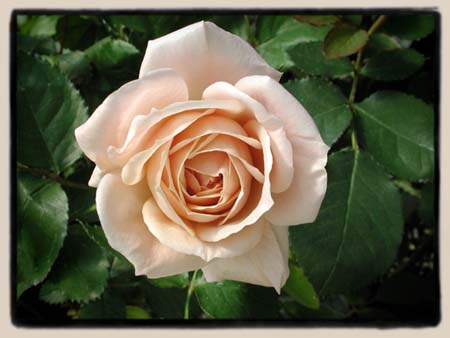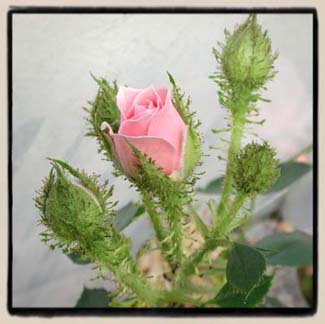 |
|
Albas |
My Favorite New Roses This Season, part two
Technically, 'Guinée' is a tall growing Hybrid Tea, but like many of its kin, it has been classified as a Large Flowered Climber, a kind of catch-all term. Bred by Mallerin in France, 1938, it came out of a cross of 'Souvenir de Claudius Denoyel' X 'Ami Quinard'. The double, intensely fragrant blooms are produced in a big display in spring, and occasionally thereafter. The color is difficult to capture in a photograph, for the blooms are often darker than they appear here, with velvety tones that shimmer and take on a blackish hue. I am told that 'Guinée' will bloom more regularly as an established plant, and it helps encourage blooms if you dead-head spent blooms.
As you can see, the fully open blooms are a very pleasant shade of amber/apricot. However, the buds can be an odd hue of olive green and tan blended together! Not everyone's cup of tea, to be sure! There is a pleasant mild fragrance and the blooms open fully and gradually fade to parchment. This is a small climber, by the way!
"Bernard Gardner lives in Los Banos, California, and has been breeding roses for his interest and enjoyment for many years. One of his intense rose interests is the creation of these unusual colors. TANTARRA was bred from Boerners 1955 hybrid tea BALINESE, itself a product of GREY PEARL and LAVENDER PINOCCHIO. Its leaves are matte, dark blue-green, yielding a lovely background for the 4", slightly fragrant, creamy tan-mahogany blooms. While they often come one to the stem, small clusters of up to three are produced. The buds are more slender than others from this line of breeding, and the flower starts off nicely high-centered. Like the others of this coloring, the rich, creamy coffee shades are most evident in cooler weather or light shade. " I am not much a fan of the Hybrid Tea growth habit, but 'Tantarra' is an exception I am willing to make. When floral arrangers get ahold of this rose, WATCH OUT! I can imagine this being exceptionally beautiful in an arrangement, along the lines of 'Julia's Rose'.
'Iced Tea's blooms are a wonderful blend of apricot and a kind of honeyed tan color on the upper petals surface, with a darker orange/chinese red below. There is a light tea fragrance as well. Blooms are produced singly and in clusters of 3 or more, and rebloom is excellent. This is a novel color, and an excellent, well-behaved plant. I think this is going to be on my favorites list for years to come. ' 'Dresden Doll' is one of the nicest Miniatures I grow, and can hardly be thought of as an ordinary pink, for it has so much grace and charm. I also grow 'Heidi', which is also bred from 'Fairy Moss', but I feel that 'Dresden Doll' has much more character, and is a more pleasing pink.
The coloring of 'Goldmoss' is much better and richer than its offspring 'Lemon Delight', and the blooms hold their color longer. Each bloom is about 3 inches across, and opens fully to display stamens. It is a most attractive rose and should be grown more often. I have acquired mine for breeding purposes as well as for garden value. Hybridizers should note that it is only sucessful as a pollen parent. Return to Part One of this article Click here for Part Three of this article
Original photographs and site content © Paul Barden 1996-2003 |
|

 I
have come to like climbing roses a lot in the past two or three years,
and so I am always adding another one or two to the collection. 'Guinée'
is one that I acquired last fall.
I
have come to like climbing roses a lot in the past two or three years,
and so I am always adding another one or two to the collection. 'Guinée'
is one that I acquired last fall.  By
now, many of you know that I have a taste for unusual colors in roses,
especially the Tan/Brown/Mahogany hues! 'Butterscotch' is a recent
addition to my collection, and is a wonderfully odd color! There are
two roses by this name, and I have the one from 1986 that J & P
introduced. It seems to have flopped commercially, likely because of
its odd coloring.
By
now, many of you know that I have a taste for unusual colors in roses,
especially the Tan/Brown/Mahogany hues! 'Butterscotch' is a recent
addition to my collection, and is a wonderfully odd color! There are
two roses by this name, and I have the one from 1986 that J & P
introduced. It seems to have flopped commercially, likely because of
its odd coloring.  Now
here is a wonderful new rose! I first learned about 'Tantarra'
from
Now
here is a wonderful new rose! I first learned about 'Tantarra'
from  Yet
another
Yet
another  While
this rose is not by any means new to me, it has remained one of my all
time favorites, and so I cannot leave it off of this list. '
While
this rose is not by any means new to me, it has remained one of my all
time favorites, and so I cannot leave it off of this list. '
